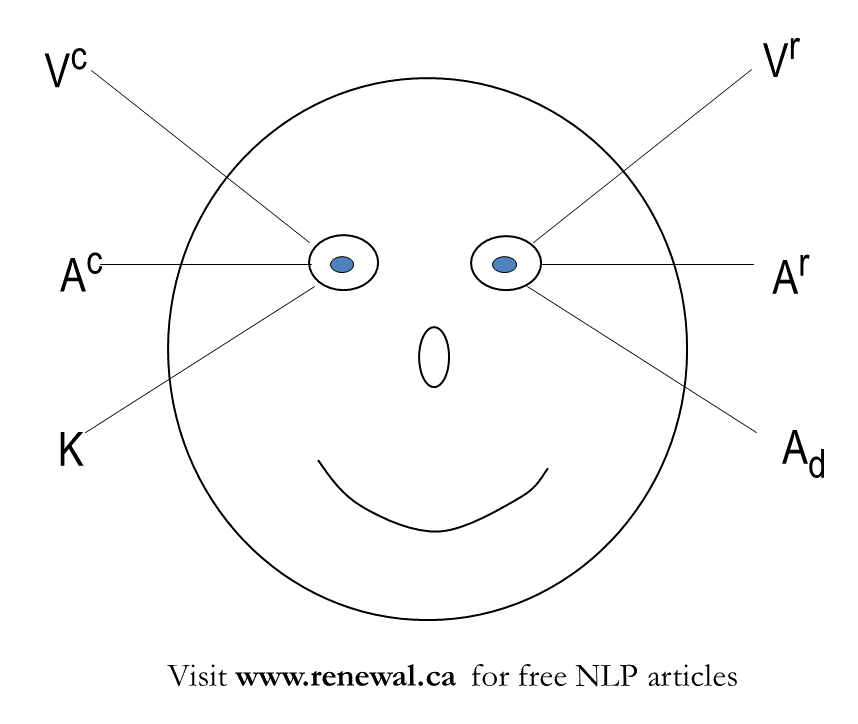Your eye movements are incredibly revealing about what you are thinking. This is simply because specific types of eye movements correlate with the mental faculties (parts or functions of the brain) that you are accessing. The eyes truly are the windows to the soul -- and, quite often the signals of your intention.
NLP practitioners, neuroscientists, psychologists and even poker players have long-realized that different eye movements tell about 1) the person, in general, and 2) what part of the mind or type of thinking the same person is going through in response to a stimulus or question.
According to neurological research, eye movement both laterally and vertically seems to be associated with activating different parts of the brain. In the neurological literature, these movements are called lateral eye movements (LEM) and in NLP, 'eye accessing cues' because they give us insights as to how people are accessing information.
To get an idea how your eyes move, consider the following questions. For each question, as you think of the answer (think first, to allow your eyes to move naturally) notice the direction(s) of your eye movements (up, down, or to the left or right side) or, if your eyes do not seem to move (although they always are -- just at very rapid intervals) notice if you have a sense that you tend to looking in a certain direction (even if only for a fraction of a second).
- What is the color of your car?
- What will you look like in 25 years?
- What does your favorite music sound like? Think of a favorite song.
- What would your voice sound like if you were speaking with a mouth full of mouthwash?
- When you talk to yourself aloud, what type of voice do you use?
- What does it feel like to be in a nice, warm, relaxing, Japanese bath?
More specifically, if you are right-handed, you may have noticed the following (for people who are left handed, interchange left and right in the following text):
- Question 1 - eyes up and to your left. This is a question about something you have seen before and hence you remembered it -- visual remembered (VR).
- Question 2 - eyes up and to your right. This is a question about something that I assume you have not seen before and hence you constructed this picture - visual constructed (VC).
- Question 3 - eyes on the horizontal plane to your left. This is a question about something you have heard before - auditory remembered (AR).
- Question 4 - eyes on the horizontal plane to your right. This is a question about something you have not heard before - auditory constructed (AC).
- Question 5 - eyes down and to the left. This is a question about your self talk - auditory digital (Ad).
- Question 6 - eyes down and to the right. This is a question about your feelings- kinesthetic (K).
Eye Pattern Chart
Looking at the Other Person (NOTE: special thanks to my fourth-grade substitute teacher for serving as our model)

Visual Remembered
What is the colour of the shirt you wore yesterday?
Which of your friends has the shortest hair?
Visual Constructed
What would your room look like if it were painted yellow with big purple circles?
Can you imagine the top half of a tiger on the bottom half of an elephant?
Auditory Remembered
What does your best friend’s voice sound like?
Which is louder, your door bell or your telephone?
Auditory Constructed
What will your voice sound like in 10 years?
What would it sound like if you played your two favourite pieces of music at the same time?
Auditory Digital
What is something you continually tell yourself?
What are your thoughts about this article?
Kinesthetic
What does it feel like to walk barefoot on a cool sandy beach?
What does it feel like when you rub your fingers on sandpaper?
The following was extracted from the BigThink Weekly IdeaFeed Newsletter. Please give it a quick read, and then hit the "BACK" button on your browser in order to come back for interesting implications and conclusions:
| CREATIVE PROCESSES Eyes Are the Windows to the Brain |
| Who a person is relates to how they move their eyes, says cognitive scientist Dr. Aaron Risko. New eye-tracking technology is giving researchers more insight into how someone thinks. |

-----------------
Using Eye Patterns to Gauge Truthfulness or Congruence
If a person is describing something that they have seen or heard, then his or her eyes should primarily move to the visual or auditory remembered positions. However --- if a person is making something up, then his or her eyes will tend to move to visual or auditory constructed, indicating that the person is constructing some part of the situation they are describing. This may indicate that the person is either uncertain or untruthful about what they are thinking. But there is indeed a big difference between being uncertain or deliberately untruthful. Either one of these tasks requires the use of reconstructive thought.
Be very careful before assuming that someone is being untruthful. For example, suppose you were to ask me a question about something that I had never thought about before. To formulate an answer, I might have to look at or hear one or more pieces of true information in a way or context in which I had never done so previously. In this situation, I would be constructing an answer and my eyes would most likely move to the visual or auditory constructed positions.
Trying to assess what or how a person is thinking utilizing eye movement tracking alone is indeed helpful, but when combined with other body signals and nonverbal communication, your "reading" of the other person becomes much more reliable.
Douglas E Castle for Sending Signals Blog, Braintenance Blog, Taking Command Blog and, of course, TwitterLinks Hubspot Blog.

Tweet
















No comments:
Post a Comment